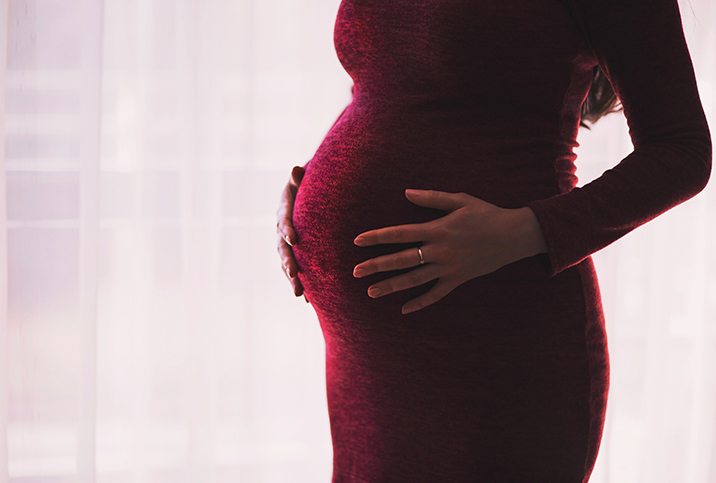More Prenatal Care Leads to Better Outcomes, New Study Finds

For people with babies on the brain, age 35 has become a bit of an albatross. That's when a pregnant person reaches what's known as advanced maternal age (AMA). While the age does have actual risks tied to it, experts say AMA doesn't mean someone's fertility or pregnancy will automatically fare worse than someone younger.
For many women, AMA status does mean they receive more prenatal care. Researchers from Harvard University and Massachusetts General Hospital studied increased prenatal care for AMA mothers and found it was associated with a decrease in perinatal mortality (stillbirths and early infant deaths). The babies of the women who were 35 were more likely to survive than the babies of the mothers who were slightly younger than 35 and received less prenatal care.
One of the study's authors, Jessica Cohen, Ph.D., researches health policy related to maternal and child health as an economist at Harvard's T.H. Chan School of Public Health. While we could reasonably assume more prenatal care would equal better pregnancy outcomes, Cohen said there hasn't been any solid evidence backing up that assertion until this 2021 study.
"From a research and clinical perspective, the study is important because it's one of the few that gives us some sense of how much value prenatal care is adding in terms of the moms' outcomes and the babies' outcomes," Cohen said.
Setting the parameters of the study
Cohen and her co-authors pulled claims data from a large commercial health insurer (which she declined to name) and looked at births between 2008 and 2019, and the medical services provided before and after birth. Their regression-discontinuity analysis included more than 51,000 pregnant people who were within 120 days of turning 35 on their expected due date—so 34 years and 8 months to 35 years and 4 months.
Choosing such a narrow sample to analyze was crucial, Cohen explained. "The idea for looking there is that there's no real reason why women who are age 34 and 10 months on their expected due date or age 35 and 2 months should really be any different from each other in terms of true underlying risk. The only real reason why those women would be different is because some of them are called 'advanced maternal age' and some of them aren't," Cohen said.
The study authors found the AMA women in their data set received more care than women just a few months younger who didn't have that designation: more ultrasounds, more fetal surveillance and more visits with maternal-fetal-medicine specialists.
"Women who are just above age 35 have substantially lower rates of losing the baby than women who are just a little bit younger," Cohen said, "suggesting that that extra attention and monitoring is leading to benefits in terms of [the baby's] survival."
35, the magic number?
The AMA designation dates back to 1979, when 35 was set as a threshold for when women should be routinely offered invasive testing for Down syndrome, through amniocentesis or chorionic villus sampling.
"The AMA designation was set there because at that age of 35, the risk of having a child with Down syndrome exceeded the risk of the procedure," said Donna Neale, M.D., medical director of the Johns Hopkins Center for Maternal-Fetal Medicine and assistant professor at the JH School of Medicine.
Any mother of any age can have a baby with chromosomal abnormalities, but that likelihood increases as she gets older. Even so, there's no switch that flips in a woman's body on her 35th birthday.
"We know that pregnancy can get riskier as women get older, generally speaking," Cohen said. "There are more risks to mom, more risks to baby. But there's nothing that magically changes at age 35 so that all of a sudden at age 35, you're much more likely to have a stillbirth or much more likely to have hypertension in pregnancy or anything like that. There's no biological reason why that changes abruptly at that age."
'There are more risks to mom, more risks to baby, but there's nothing that magically changes at age 35.'
Neale agrees. "There's no magic about 35," she said. "The genetics data is quite clear, so there is risk as we get older. There's no doubt about it. But on the flip side, we know that a 35-year-old who's healthy may do better [in pregnancy] than a 25-year-old who has diabetes, hypertension and lupus."
While the JAMA study found important benefits for fetal and infant survival, the increased prenatal care didn't appear to translate to improved maternal outcomes or mortality rates. It was the babies who received additional monitoring, not the mothers, Cohen explained. Maternal morbidity is higher in the U.S. than in any other highly resourced nation, particularly for non-white mothers. There's also a huge disparity in infant mortality between white and non-white babies, Neale said.
The JAMA study also couldn't pinpoint exactly which type of care or intervention was responsible for the improved outcomes for babies—something Cohen said she found to be "frustrating."
"But what we can say, pretty confidently," Cohen concluded, "is that the extra attention and monitoring, broadly speaking, is leading to benefits."


















